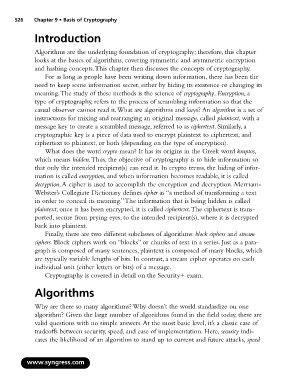Page 542 - StudyBook.pdf
P. 542
526 Chapter 9 • Basis of Cryptography
Introduction
Algorithms are the underlying foundation of cryptography; therefore, this chapter
looks at the basics of algorithms, covering symmetric and asymmetric encryption
and hashing concepts.This chapter then discusses the concepts of cryptography.
For as long as people have been writing down information, there has been the
need to keep some information secret, either by hiding its existence or changing its
meaning.The study of these methods is the science of cryptography. Encryption,a
type of cryptography, refers to the process of scrambling information so that the
casual observer cannot read it.What are algorithms and keys? An algorithm is a set of
instructions for mixing and rearranging an original message, called plaintext, with a
message key to create a scrambled message, referred to as ciphertext. Similarly, a
cryptographic key is a piece of data used to encrypt plaintext to ciphertext, and
ciphertext to plaintext, or both (depending on the type of encryption).
What does the word crypto mean? It has its origins in the Greek word kruptos,
which means hidden.Thus, the objective of cryptography is to hide information so
that only the intended recipient(s) can read it. In crypto terms, the hiding of infor-
mation is called encryption, and when information becomes readable, it is called
decryption.A cipher is used to accomplish the encryption and decryption. Merriam-
Webster’s Collegiate Dictionary defines cipher as “a method of transforming a text
in order to conceal its meaning.”The information that is being hidden is called
plaintext; once it has been encrypted, it is called ciphertext.The ciphertext is trans-
ported, secure from prying eyes, to the intended recipient(s), where it is decrypted
back into plaintext.
Finally, there are two different subclasses of algorithms: block ciphers and stream
ciphers. Block ciphers work on “blocks” or chunks of text in a series. Just as a para-
graph is composed of many sentences, plaintext is composed of many blocks, which
are typically variable lengths of bits. In contrast, a stream cipher operates on each
individual unit (either letters or bits) of a message.
Cryptography is covered in detail on the Security+ exam.
Algorithms
Why are there so many algorithms? Why doesn’t the world standardize on one
algorithm? Given the large number of algorithms found in the field today, these are
valid questions with no simple answers.At the most basic level, it’s a classic case of
tradeoffs between security, speed, and ease of implementation. Here, security indi-
cates the likelihood of an algorithm to stand up to current and future attacks, speed
www.syngress.com

